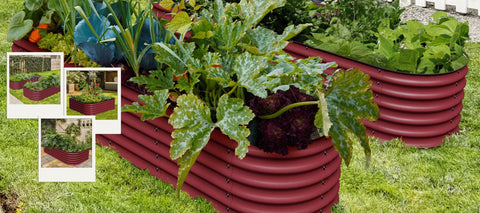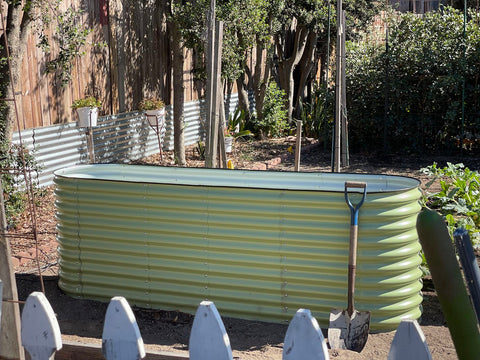Does The Raised Garden Bed Have To Be Level?
Gardeners face various challenges when setting up garden beds. They not only need to determine the best platform for their garden, but also deal with building materials. Another challenge is to choose the right soil for the plants they plan to grow. There is no suitable condition in the raised garden bed, and you will have low yield or encounter various troubles in the planting process.
Another challenge for gardeners is to set up raised garden beds on hills or grasslands. This leads us to the question - must the raised garden bed be horizontal? No, it's not mandatory. However, the horizontal garden bed provides the best conditions for your plants to thrive. If the land is uneven, it should be a little sloppy, not too sloppy.

Build raised garden beds on uneven surfaces
The terrain where you want to erect the raised garden bed is crucial. Some areas are hilly while others are uneven. Instead of flattening the entire area, you can adjust the type of garden bed you create. Most farmers first build beds on the higher side of the slope. Then they raised the downhill edge of the garden bed until it was level.
Building a raised garden bed on an uneven surface can be very challenging because you may need to use your eyes to make sure it is level. In addition, you may have to worry about the type of soil you use, as it varies depending on the depth of the slope. If you want the plants to get the best results, a raised garden bed will be the best.
This brings many advantages, such as proper absorption of nutrients and water. In addition, nutrients, soil and sunlight will be mixed together to form the best environment for plant growth. You will prevent soil erosion, which may take away topsoil and rich nutrients.
The advantage of a garden bed with a raised level
Absorb water and nutrients
A raised garden bed is essential because it ensures that moisture and water are absorbed by the soil.
The horizontal garden bed makes the roots easy to absorb the important nutrients and water needed for growth.
On the contrary, uneven surfaces do not enjoy the same benefits as water in removing topsoil and other nutrients.
When it rains, the leaves and roots of plants on the horizontal surface are hydrated, which helps distribute nutrients throughout the plant.
But for plants on uneven garden beds, only their leaves will absorb nutrients, not their roots.

In addition, an uneven garden may have a place where all the water gathers together to form a breeding ground for pollutants and other wastes.
Prevent soil erosion
The most significant advantage of having a raised garden bed is that you will not experience soil erosion. The uneven surface will experience a lot of soil erosion, washing away the topsoil and its rich nutrients and minerals. As a result, your plant will lack many essential nutrients, leading to some defects. If you plant plants on a raised garden bed, you will not encounter this problem. Instead, plants will receive all the nutrients they need for healthy growth.
Receive enough sunlight
In addition, the horizontal garden bed provides enough sunlight for the plants because it shines from all directions.
But on a slope, one side gets more light than the other. This means that the side of the plant will not grow as fast as the side facing the sun.
Therefore, the leaves on the side of the plant that cannot receive enough light will grow towards the sun. However, plants on flat soil that receives the same amount of sunlight in all parts will grow steadily without bending.
What happens if the raised garden tilts?
If your raised garden bed is tilted, many things can go wrong.
It is not difficult for most plants to grow on uneven land, but if there are a large number of plants on the same slope, they will be difficult to grow and produce fruits normally.
When you water plants planted on grassland soil, the water distribution between plants is uneven. The plants at the top of the land dry up first.
Finally, the sloping garden bed makes the plants grow unevenly.

How to level a raised garden bed on a slope
We have seen that raised or horizontal garden beds are essential for plant growth and productivity. But what can you do if your land is sloppy?
In this case, a flat raised garden bed is the best solution.
To level a raised garden bed on a slope:
- Put the garden box in a dirty place and dig out the soil.
- Use a tape measure from the bottom of the box to the soil surface. This survey will give you clues about the level or depth of soil that needs to be removed.
- Make sure that the part where the garden bed is located is free of weeds.
- The required depth of excavation from the upper end of the slope
- Once your garden bed is perfectly located on the ground, you can fill it with soil.
Epilogue
Whether you live on sloping or flat land, you can erect raised garden beds as needed. More importantly, no matter what your terrain is, if you want plants to grow steadily and healthily, you need a horizontal garden bed. It is a good idea to install a raised garden bed on an uneven surface, but it has several limitations. If you live on a slope, make some adjustments to raise the level of the garden bed. A raised garden bed will not erode the soil, but it will better absorb nutrients and water.
In addition, it will receive even sunlight, which is different from slopes with shaded areas. With these conditions, your plant will grow well and get everything it needs to thrive.
